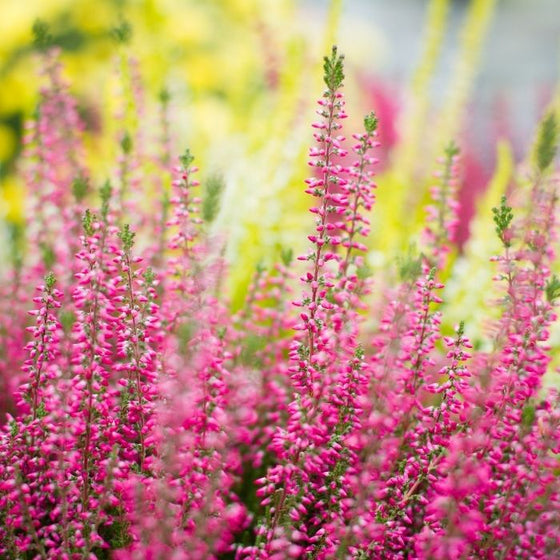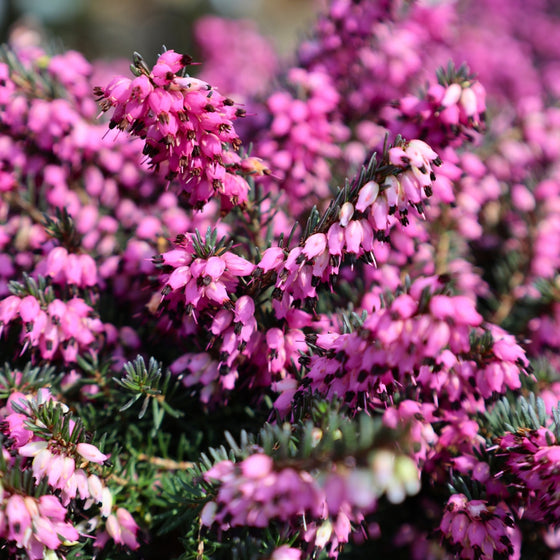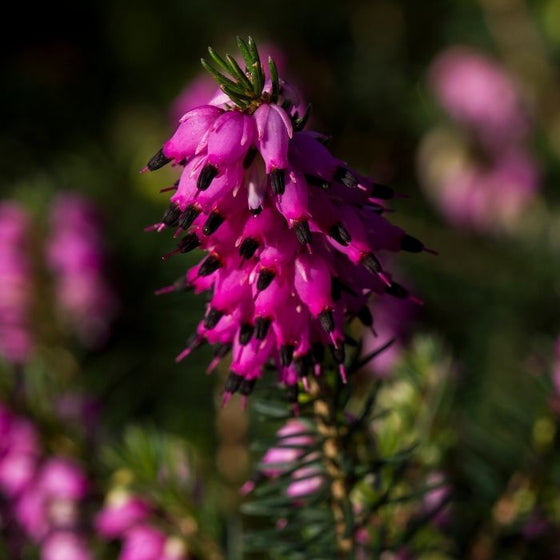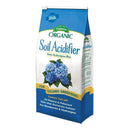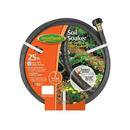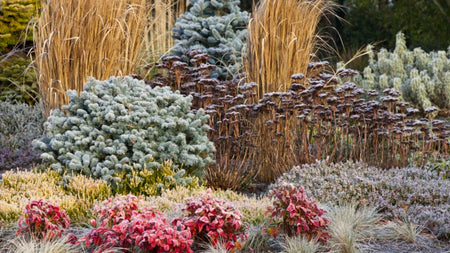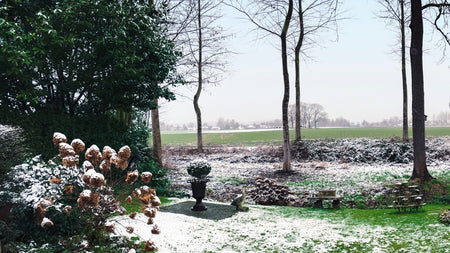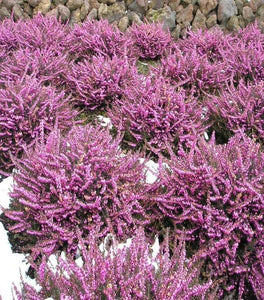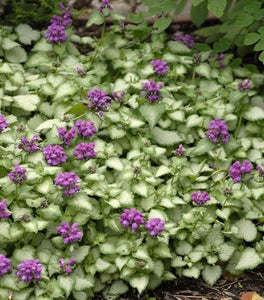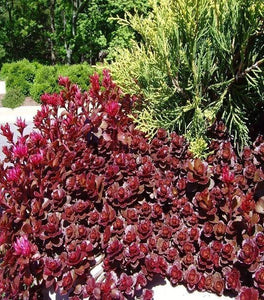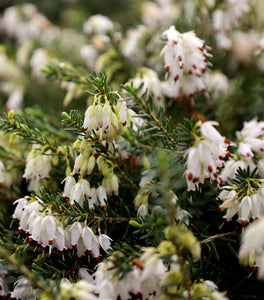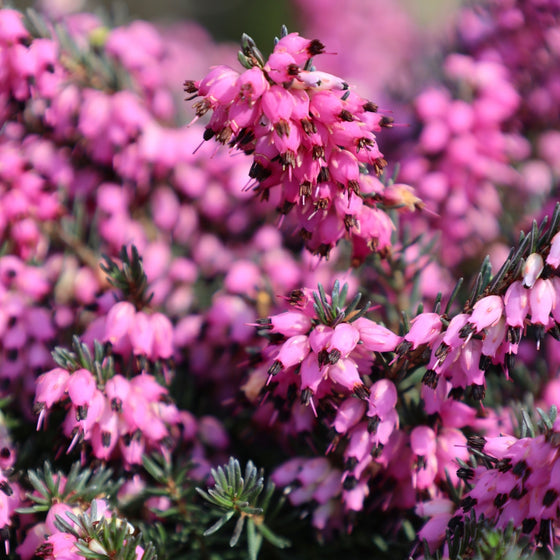
Images Depict Mature Plants
Kramer's Red Heather Plants
Kramer's Red Heather (Erica x darleyensis ‘Kramer’s Red’) is a vibrant, evergreen shrub celebrated for its brilliant magenta-red blooms that appear in late winter and early spring. This hardy heather variety offers an outstanding burst of color during the dreariest months, brightening up landscapes with its showy flowers and fine-textured, dark green foliage. Compact and low-growing, Kramer’s Red forms a dense, mounded habit, typically reaching 12 to 18 inches in height and spreading 18 to 24 inches wide, making it perfect for rock gardens, borders, and groundcovers.
Thriving in full sun and well-drained, acidic soils, Kramer's Red Heather is drought-tolerant once established and requires minimal maintenance, making it ideal for low-water gardens and easy-care landscapes. It’s also deer-resistant, adding another layer of reliability in rural and suburban settings. Its evergreen foliage provides year-round texture and visual interest, while its early blooms offer an important nectar source for pollinators when few other plants are in flower. Grouped in mass plantings or mixed with other early-blooming shrubs, it creates stunning, colorful displays that welcome the arrival of spring.
Whether used to accent a sunny slope, edge a walkway, or fill in between boulders and ornamental grasses, Kramer’s Red Heather delivers bold seasonal color and soft, evergreen structure. Its resilience to harsh conditions and beautiful flowering period make it a standout addition to coastal gardens, alpine settings, and any landscape needing cheerful, low-growing color. With its compact form, long bloom time, and easy care requirements, Kramer's Red is an exceptional choice for gardeners seeking beauty and reliability in every season.
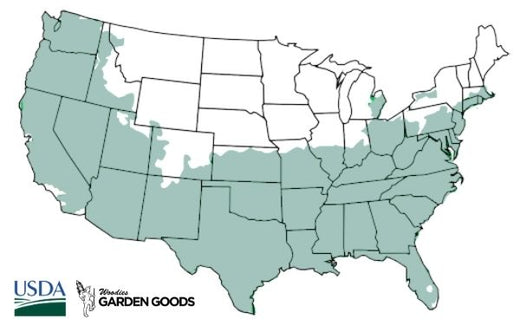
| Hardiness Zone: | 5-8 |
|---|---|
| Mature Height: | 1 to 2 feet |
| Mature Width: | 2 to 3 feet |
| Classification: | Fine leaved evergreen shrub; Late-winter flowering |
| Sunlight: | Full sun to part shade |
| Habit: | Evergreen, mounding |
| Flower Color: | Dark reddish-pink |
| Foliage: | Dark green |
| Soil Condition: | Any well drained soil |
| Water Requirements: | Water well until established |
| Uses: | Extremely attractive when used as a groundcover in the mixed border, mass planting, or a specimen planting. Provides unmatched late winter interest due to its flowering in the early winter |
How to Care for Kramer's Red Heather
Before you buy a Kramer's Red Heather, make sure to read about the care instructions that are recommended to keep this plant healthy and thriving.
How do I Plant a Kramer's Red Heather Plant?
To plant a Kramer’s Red Heather successfully, choose a location that receives full sun to light partial shade and has well-drained, acidic soil. Begin by digging a hole twice as wide and just as deep as the plant’s root ball. Gently remove the heather from its container, loosen any circling roots, and place it in the hole so that the top of the root ball is level with the surrounding soil. Backfill with a mix of native soil and organic material like compost or peat moss to enhance drainage and acidity, and water thoroughly to help settle the soil around the roots. Space multiple Kramer’s Red Heather plants about 18 to 24 inches apart to allow them room to spread and form a dense, colorful carpet. Mulch around the base with pine bark or pine needles to maintain soil moisture, suppress weeds, and help maintain the acidic conditions that heather loves. Avoid heavy clay or soggy soils, as poor drainage can quickly lead to root rot. With proper planting and a well-chosen site, Kramer's Red Heather will thrive, offering brilliant winter-to-spring color, evergreen texture, and reliable performance in borders, rock gardens, and sunny slopes.
How do I Water a Kramer's Red Heather Plant?
Watering your Kramer’s Red Heather correctly is key to establishing a healthy, vibrant plant that will deliver brilliant winter and early spring color. After planting, water deeply two to three times per week for the first few months to encourage strong root development, making sure the soil stays consistently moist but not waterlogged. Use a soaker hose or gentle hand watering at the base of the plant to keep moisture near the roots while minimizing wet foliage, which can help prevent fungal issues. Well-drained soil is essential, as Kramer’s Red Heather is sensitive to overly saturated conditions. Once established, Kramer’s Red Heather becomes more drought-tolerant and typically only requires supplemental watering during prolonged dry periods or extreme heat. Regular monitoring is important; water when the top 2–3 inches of soil feel dry to the touch. Applying a layer of mulch, such as pine needles or bark, around the base helps retain moisture and maintain the acidic soil conditions that heather prefers. Proper watering will ensure that your Kramer’s Red Heather stays healthy, lush, and ready to burst into brilliant magenta bloom when other plants are still waking up from winter.
How do I Fertilize a Kramer's Red Heather Plant?
Fertilizing your Kramer’s Red Heather plant properly supports vigorous growth, vibrant blooms, and healthy evergreen foliage. In early spring, just as new growth begins, apply a slow-release, acid-loving fertilizer—similar to what you would use for azaleas or rhododendrons. Look for a balanced formula such as 10-10-10 or one slightly higher in phosphorus to encourage strong flowering. Spread the fertilizer evenly around the base of the plant, keeping it several inches away from the stems, and water thoroughly to help nutrients penetrate the soil and reach the roots. For ongoing health, a second light application of fertilizer can be made in mid-summer, particularly if the soil is sandy or naturally low in nutrients. Organic options, like composted pine needles or an acidic mulch, can also help maintain the soil’s slightly acidic pH while adding slow-release nutrients. Avoid high-nitrogen fertilizers, which can encourage excessive leafy growth at the expense of flowers. With a consistent, moderate fertilization routine, your Kramer’s Red Heather will reward you with a thick, colorful carpet of blooms and lush greenery, perfect for brightening borders, slopes, and rock gardens.

How and When should I Prune a Kramer's Red Heather Plant?
Pruning your Kramer’s Red Heather plant at the right time helps maintain its neat, mounded shape and encourages fuller, more vigorous growth. The best time to prune is immediately after the plant finishes flowering in late spring. Using clean, sharp pruning shears, lightly trim back the spent flower stems and any leggy or unruly growth, being careful not to cut into the older, woody parts of the plant, as heather does not readily regrow from bare wood. This post-bloom pruning promotes dense branching and sets the stage for a more compact, lush plant in the next growing season. Throughout the year, you can also perform light maintenance pruning to remove any dead, damaged, or winter-burned tips, keeping your Kramer's Red Heather looking tidy and healthy. Regular, careful pruning not only enhances the plant’s appearance but also extends its lifespan and flowering performance. Avoid heavy pruning in late summer or fall, as this can remove buds that are forming for the next bloom cycle. With thoughtful, timely pruning, your Kramer’s Red Heather will thrive as a vibrant, evergreen centerpiece in sunny borders, rock gardens, and low-maintenance landscapes.

